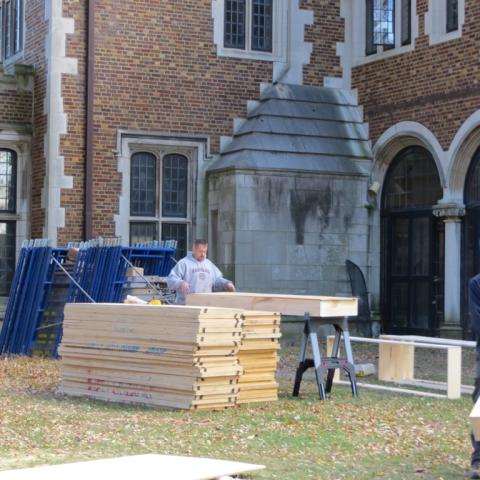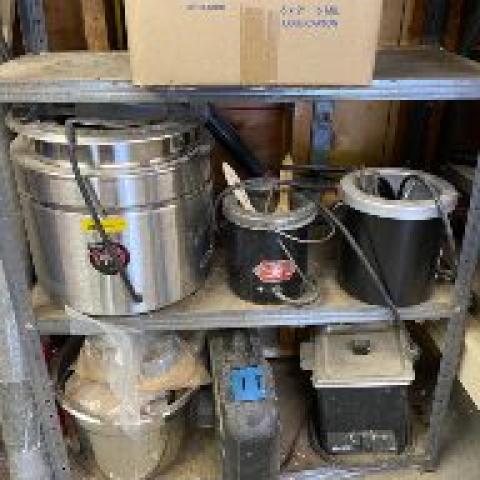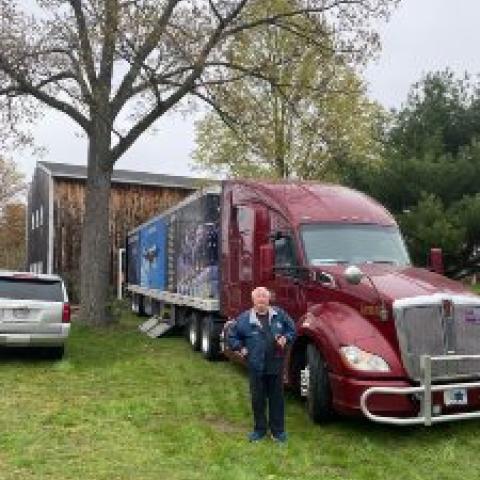
Let’s hoist a few.
On September 24, 2023, Alyson Krueger published an article in The New York Times under the headline, “My Running Club, My Everything,” telling of the culture of running clubs in New York City in which twenty-five or more people gather at a specified meeting place and run together for four or five miles. She described an outing of the Upper West Side Running Club that met at the American Museum of Natural History (Central Park West at Eighty-First Street) where members ran a loop around Central Park and wound up at the Gin Mill on Amsterdam Avenue at Eighty-First Street, one block west of the museum. I chuckled as I read because the Gin Mill is a favorite after hours haunt of the Organ Clearing House crew. I wonder how many of you reading this have sat there with our guys?
The Gin Mill has a happy hour routine with discounted drinks, and if you are anything like a regular and the bartender knows you, it seems as if you are charged by the hour. Your glass gets magically and repeatedly refilled, and the closing check is a nice surprise. I have spent quite a few evenings there, but our boots-on-the-ground crew has spent dozens. In 2010 the crew spent most of the summer hoisting organ parts into the chambers at the Cathedral of Saint John the Divine, followed by hoisting pints and other concoctions at the Gin Mill. Numerous subsequent projects have allowed reunions with the friendly staff there—friendly to good natured partyers, but hard on bad apples.
Since so many of our projects involve hoisting organ components in and out of balconies, towers, and high chambers, I spend a lot of time talking with scaffolding vendors around the country. I have first-name relationships with reps in a dozen cities, as well as with our personal representatives from national scaffolding vendors. We own several electric hoists, including one with a 100-foot reach purchased for that job at Saint John the Divine that can hoist a 2,000-pound load 100 feet in two minutes with a soft start and stop. A multiple-week job like that means that someone has held a finger on the up or down button for dozens of hours. We like to ship our own hoist across the country because specialized rental equipment like that can be hard to find and in poor condition. In a usual setup, the hoist is hung from a trolley that rolls on an I-beam so a heavy load like a four-manual console or ten-stop windchest can be lifted clear of a balcony rail, trolleyed out over the nave floor, and safely lowered. Safely for the console, safely for our crew.
The bells, the bells
Wendy and I left our apartment in Greenwich Village on the heels of the pandemic and moved early last year to bucolic Stockbridge in western Massachusetts, about five miles from the New York border. Our house is three doors up Church Street from Main Street where stands the granite Children’s Chime Tower on the Village Green that is shared by the First Congregational Church. After we moved in, we were delighted to learn that we can hear the largest bell ringing the hour, every hour, from the house—no more wondering what time it is in the middle of the night.
The tower was built in 1879, the gift of David Dudley Field II, son of David Dudley Field, pastor of the Congregational Church, and his wife, Submit (really). David II was a prominent New York politician and attorney who represented William Magear “Boss” Tweed in his Tammany Hall embezzlement trial. (Tweed died in prison.) David II dedicated the tower to his grandchildren, stipulating that the chimes should be played every day from “apple blossom time to first frost.” His grave is in the Stockbridge Cemetery, just across Main Street from the Chime Tower. My grandfather was rector of Saint Paul’s Episcopal Church in Stockbridge when I was a kid, and I remember sitting on that green with my grandmother at picnic suppers listening to recitals on the chimes. The music was simple as there are only eleven bells, but since it was more than fifty years ago, I remember it as grand. That tradition continued until recently when the timber frame supporting the chimes was deemed unsafe due to an infestation of carpenter ants.
The big bell continued to ring every hour until a storm caused a power failure last spring, stopping the clock at 2:16. The clock was not reset after the storm, leaving us wondering about the time during the night. At the last town meeting, the citizens approved rebuilding the chimes with a new steel frame, refurbishing the chimes’ playing action, replacing the roof, and re-pointing the stone work.
I was returning to Stockbridge last week from our place in Maine and saw a large crane set up next to the tower. I went home, unloaded the car, walked back to the green with Farley the Goldendoodle to see what was going on, and I found three men from the Verdin Company of Cincinnati, Ohio, preparing to hoist the bells back into the tower. They had removed them earlier in the week, placing them on a flat-bed trailer owned by the town so they could be driven to safety overnight at the public works yard a half-mile away. The new steel frame was in place, and they were hoisting the bells with their new striking mechanisms back into the tower.
In the twenty months since we moved to town, we had only heard the largest bell as it tolled the hours, but now, as the people from Verdin were putting things together and testing the new actions, I heard all the bells for the first time in more than fifty years. At least one of the technicians knew how to play a little so a few hymns and a couple children’s songs wafted up the street to our house. Before they left town, they set and started the clock, freeing it from 2:16 to cover all 720 minutes of the twelve-hour cycle. The morning after the first night of tolling the hour, I was walking Farley a few minutes before 7:00 and ran into our neighbor Marty with Brody the Labrador at the poop-bag kiosk across from the tower. When the bell tolled the hour and we were chatting about the return of the bells, Marty told me that Stewart across the street used to play the chimes and was looking forward to volunteering again when the rest of the work on the tower is complete and the chime goes back into service. I suppose I will, too.
Doing it the old-fashioned way
After Wendy and I visited Florence, Italy, in May 2023, I wrote about the hoisting equipment designed by Filippo Brunelleschi for the construction of the dome of the cathedral there. He had won the design competition in 1418, and construction started in 1420 on what is still the largest unsupported dome in the world. Brunelleschi’s hoisting gear was powered by oxen walking on a circular treadmill on the floor of the cathedral, a rig that was a lot messier and required more maintenance than what we use on our job sites. He made use of blocks and tackle, the same as used to handle the rigging of sailing ships. It is fun to picture workers hauling hay into the church to feed the oxen, and I suppose there was a poop-bag kiosk there also.
The real genius of Brunelleschi’s hoist was the crane at the top that could transfer stones weighing thousands of pounds laterally to every spot in the circumference of the dome. In the world of rigging, it is one thing to hoist a heavy load vertically; it is a very different challenge to move horizontally from under the hoisting point.
We marvel at ancient feats of lifting. Stonehenge in Wiltshire, England, is believed to be between four- and five-thousand years old. It includes some thirty stones, some as heavy as twenty-five tons. The stones came from a quarry sixteen miles away—simply bringing them to the site was effort enough. In most American states, the weight limits on tandem axles of commercial trucks are between 25,000 and 40,000 pounds. Rhode Island has the highest limit, 44,800 pounds, which is about the weight of one of the stones at Stonehenge. The Grove crane that was helping my friends from Verdin hoisting bells is a robust machine with a fifty-ton lifting capacity. The engineers and laborers at Stonehenge would have been pleased with help from Gary the crane operator.
We visit iconic churches in Europe built in centuries past and admire their seventeenth- and eighteenth-century organs. The monumental organ completed in 1738 by Christian Müller at the church of Saint Bavo in Haarlem, the Netherlands, has 32′ pipes in the pedal tower. As modern organbuilders, we know how much work it is to handle things like that. Those eighteenth-century craftsmen worked very hard.
I was twenty-one years old when my mentor John Leek and I helped a crew from Flentrop in Zaandam, the Netherlands, install the three-manual organ at Trinity Episcopal Cathedral in Cleveland, Ohio. The organ has a beautiful twenty-five-foot mahogany case topped with a massive crown with heavy moldings that stands on a pedestal balcony something like fifteen feet above the floor. The balcony is shallower than the organ case so when you are up on top, you look straight down to the floor.
There is a polished 16′ Principal in the façade, and come to think of it, we installed that organ using technology and equipment similar to that used by Brunelleschi, lifting everything to the balcony and into the organ using a block-and-tackle with hemp rope. Looking back, it would have been a lot more pleasant had anyone thought of using nylon rigging rope like you find on a modern sailboat because that hairy, prickly hemp was hard on our hands. The heaviest piece of the organ was the impost frame with the huge moldings that form the bases of the case towers and the rigid structure that connects the lower and upper cases. I suppose it weighed around 1,500 pounds; so instead of oxen, there was me and a young guy from Flentrop pulling on the rope. We were much neater and easier to maintain than Brunelleschi’s oxen. My sixty-seven-year-old shoulders and back could no more do that kind of work now than fly me to the moon.
To lift the big shiny façade pipes up to the case, a co-worker picked up the top of the pipe and climbed a ladder from the nave floor to the balcony as others moved the toe end toward the ladder, bringing the pipe to vertical. I wore a leather harness around my waist as if I was carrying a flagpole in a parade, we placed the toe of the pipe in the cup, and I climbed the ladder, toe following top as the others above me balanced and guided it into place. Today I stand in a church gazing up at the organ, remembering doing that work, incredulous. I am not half the man I used to be.
I have been with the Organ Clearing House for nearly twenty-five years, watching my colleague Amory Atkins set up scaffolding and hoisting equipment on dozens, even hundreds of job sites. There is still plenty of hustle to the work, but the I-beams, trolley, and electric hoist all supported by steel scaffolding make for a much safer and less strenuous work site.
Making the impossible possible
When I was running the Bishop Organ Company in the Boston area in the 1980s, we had a releathering project in the large organ of one of Boston’s great churches. As usual, we started the job with a string of heavy days disconnecting organ components covered with decades of city grime and removing them from the organ for transportation to our workshop. After we had wrestled a particularly awkward and heavy part down the ladders and out of the building, one of my employees announced that now he thought he understood organbuilding. “It’s squeezing into tiny spaces to remove screws you can’t reach, to separate a part of the organ the size of a refrigerator that’s covered with mud and sharp pointy things and carrying it down a ladder next to a Tiffany window.”
He was right. A big manual windchest might weigh 800 or 1,000 pounds, more for a large console. If we are planning to dismantle or install a Skinner organ that has one of those wonderful electro-pneumatic harps, we might plan an entire day to handle that single specialty voice—they are big and heavy and include row after row of little prickly things that dig into your hands, arms, and shoulders. When I hear a harp in service playing, recital, or recording, my mind jumps instantly to the titanic struggles I have had moving them. They sound so ethereal in a lofty room, but they are pugnacious bulky brats to handle.
The thrilling rumbles of big 16′ and 32′ stops do not happen anywhere else in music, but again, my mind jumps to the herculean task of moving such things. The pipes, racks, and windchests of a 32′ Double Open Wood weigh many tons and will fill half of a semi-trailer. One of the marvels of the pipe organ is the idea that a single pipe might be approaching forty feet in length including pipe foot and tuning length, weigh close to a ton, and can produce only one musical tone at one pitch at one volume level. What a luxurious note.
When I meet people at social events, they are invariably surprised when they learn about my work. “A pipe organ builder. I didn’t know there were any of you left.” Another common comment is someone remembering the organ looming high in the back of the church and if they ever gave it any thought, they assumed that it was part of the building. Not so. Every organ in every building anywhere in the world was put there intentionally by craftsmen. They had to figure out how to mount and secure each heavy component. Think of the sprawling sixteenth-century organ case at the cathedral in Chartres. It gives the impression that it is somehow hanging from the stained-glass windows, but 500 years ago, those workers built scaffolding clear up to the clerestory windows and hoisted and lugged the heavy woodwork and huge pipes to their lofty spots.
Twenty years ago, we were delivering a three-manual organ to a church in suburban Richmond, Virginia. There was a big organ case with polished façade pipes, five large windchests, all the machinery and ductwork for the wind system, seventy or eighty eight-foot pipe trays full of nicely packed pipes, the console, and all the mysterious looking bits and pieces that make up a full-sized pipe organ. Parishioners volunteered on a Sunday afternoon to help unload the truck, and by day’s end the sanctuary was jam packed with carefully made, expensive looking stuff. I had worked with the church’s organ committee and governing board to create and negotiate the project and knew several of the people involved very well. After the dust had settled that evening, one of them came up to me and commented, “John, it wasn’t until this moment that I understood why organs cost so much money.”







